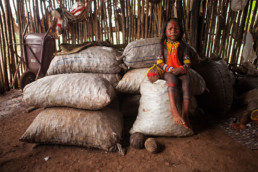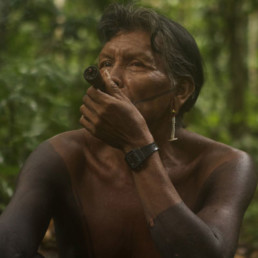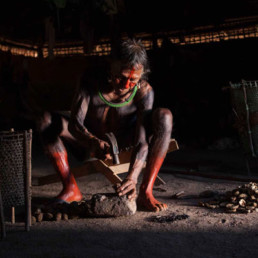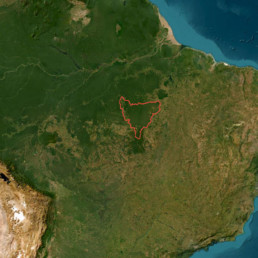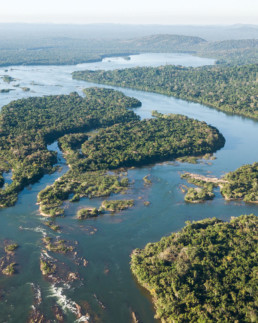The Kayapo People
The Mẽbêngôkre, a people whose name can be translated as “People of the Water Hole,” refer to themselves as such. In the past, other Tupi-speaking peoples labeled them, and they became more widely known as the “Kayapó,” a name that gained popularity among non-indigenous.
The Mẽbêngôkre speak a language from the Jê family and inhabit villages ranging from 50 to 600 people. Residing in a transition region between the cerrado and the Amazon forest, as well as within the forest itself, the center of their village, known as ngàipôk-ri, serves as the focal point of their cosmological universe.
The Kayapo dedicate a large part of their time and energy to organizing and executing rituals, preceded by collective hunting or fishing. Body painting is part of everyday life in the village, and this activity is carried out by menire women from the moment they become mothers. Body Painting represents a very striking characteristic of their culture. They are very proud of the beauty of their painting, their rituals, and their art!
In their mythology, Indigenous People, plants, fish, and other animals transform, thus creating an important kinship relationship between humans and nature. These transformations are the stories of great adventures that only elders know how to tell. This cosmology guides their way of understanding and acting in the world and nature.
Spanning more than 100,000 km2, Kayapo’s land is larger than many countries around the world.
In Southeast Amazonia, situated on the forefront of deforestation, a vast expanse of untouched rainforest is safeguarded by the Kayapo. Their territories harbor the final expansive, undisturbed stretch of indigenous forest in the southeastern Amazon, serving as a vital link connecting this ecoregion with the western Amazon. The Kayapo’s presence yields immeasurable advantages in terms of biodiversity protection, climate change mitigation, and the preservation of the pivotal role played by Amazonian forests in generating rainfall across a significantly broader geographical scope.
The mighty Xingu river and its main tributary, the Iriri river flow undisturbed through Kayapo’s indigenous land. Their waters are teeming with life and provide the Kayapo with their main source of protein. The ecological importance of the Xingu and Iriri rivers cannot be overstated, as these rivers harbor a diverse array of fish and other aquatic animals. Seasonal fluctuations in their levels flood the soil of the rainforest with mineral-rich sediments, fertilizing the land and providing sustenance for the rich fauna of the region.
The Kayapo People, represented by their community, actively fight for the guarantee of their traditional rights and territories, as granted by the Brazilian Constitution. The Constitution recognizes their ownership of the Territory, making them responsible for the conservation of extensive areas of forests and savannas. The Kayapo’s stewardship plays a crucial role in directly contributing to biodiversity conservation and maintaining the equilibrium of rainfall and climate across the planet.
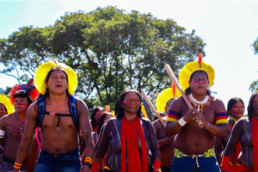
Most Kayapo are part of a Kayapo-NGO alliance which has been extremely successful at protecting Kayapo land and culture. The Kayapo, renowned for their high level of political and social organization, have achieved success through their active engagement in various initiatives. They participate in political protests and numerous conservation programs, focusing on sustainable economic activities, territorial surveillance, research and ecotourism.
